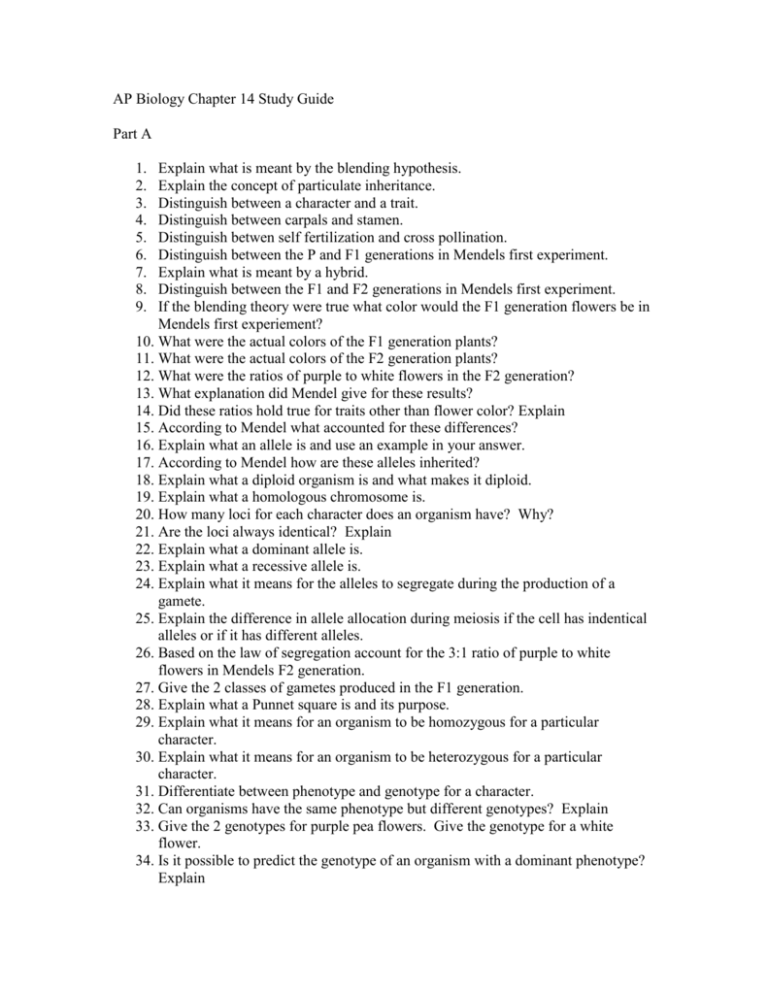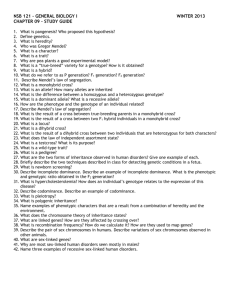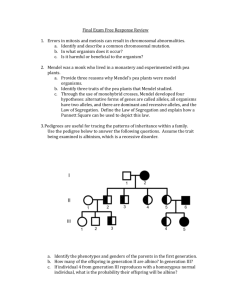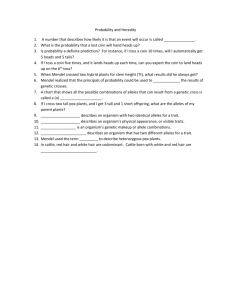AP Biology Chapter 14 Study Guide
advertisement

AP Biology Chapter 14 Study Guide Part A 1. 2. 3. 4. 5. 6. 7. 8. 9. Explain what is meant by the blending hypothesis. Explain the concept of particulate inheritance. Distinguish between a character and a trait. Distinguish between carpals and stamen. Distinguish betwen self fertilization and cross pollination. Distinguish between the P and F1 generations in Mendels first experiment. Explain what is meant by a hybrid. Distinguish between the F1 and F2 generations in Mendels first experiment. If the blending theory were true what color would the F1 generation flowers be in Mendels first experiement? 10. What were the actual colors of the F1 generation plants? 11. What were the actual colors of the F2 generation plants? 12. What were the ratios of purple to white flowers in the F2 generation? 13. What explanation did Mendel give for these results? 14. Did these ratios hold true for traits other than flower color? Explain 15. According to Mendel what accounted for these differences? 16. Explain what an allele is and use an example in your answer. 17. According to Mendel how are these alleles inherited? 18. Explain what a diploid organism is and what makes it diploid. 19. Explain what a homologous chromosome is. 20. How many loci for each character does an organism have? Why? 21. Are the loci always identical? Explain 22. Explain what a dominant allele is. 23. Explain what a recessive allele is. 24. Explain what it means for the alleles to segregate during the production of a gamete. 25. Explain the difference in allele allocation during meiosis if the cell has indentical alleles or if it has different alleles. 26. Based on the law of segregation account for the 3:1 ratio of purple to white flowers in Mendels F2 generation. 27. Give the 2 classes of gametes produced in the F1 generation. 28. Explain what a Punnet square is and its purpose. 29. Explain what it means for an organism to be homozygous for a particular character. 30. Explain what it means for an organism to be heterozygous for a particular character. 31. Differentiate between phenotype and genotype for a character. 32. Can organisms have the same phenotype but different genotypes? Explain 33. Give the 2 genotypes for purple pea flowers. Give the genotype for a white flower. 34. Is it possible to predict the genotype of an organism with a dominant phenotype? Explain 35. Explain what testcross is an give an example. 36. Explain the difference between a mono and a dihybrid cross. 37. Explain what it means for each character to be inherited independently. 38. Explain Mendel’s law of independent assortment. 39. Explain how Mendel’s law of independent assortment follows the laws of mathematical probability. 40. Does one toss of a coin affect the next? Explain 41. Explain the relationship between a coin toss and the fertilization process. 42. Explain how the rule of multiplication applies to both a mono and a dihybrid cross. 43. Explain how the rule of addition applies to mono and dihybrid crosses.









